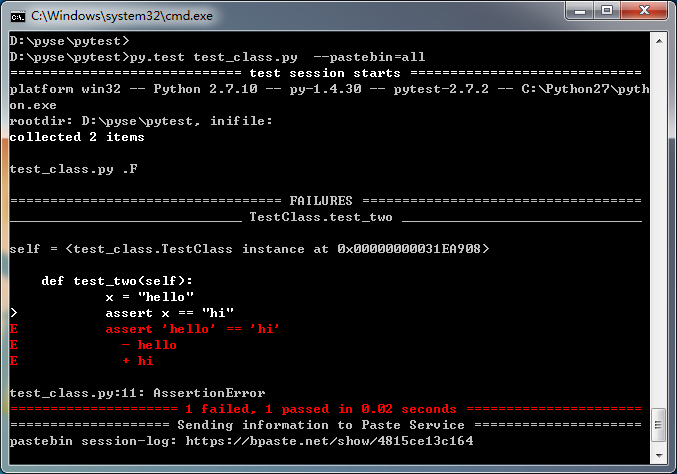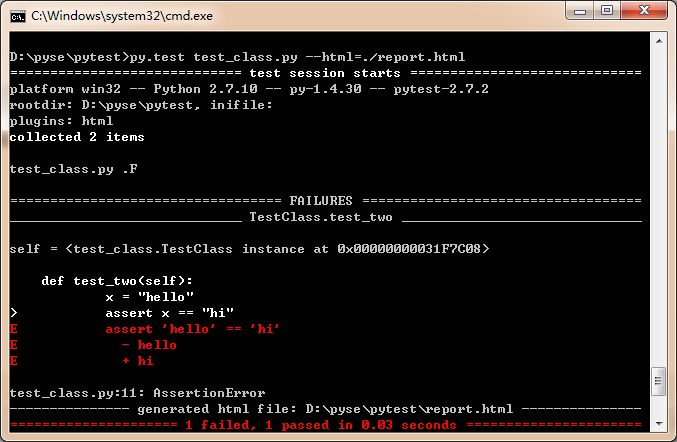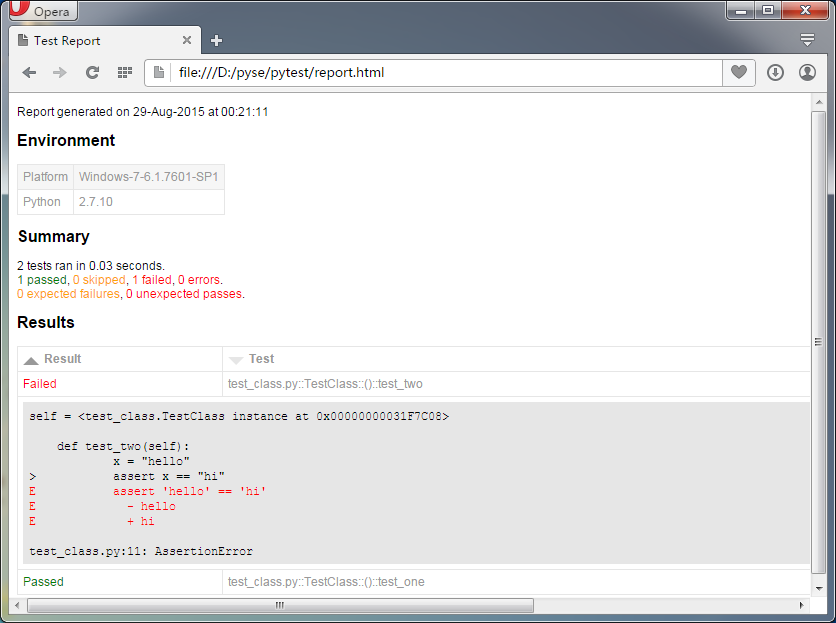Python单元测试框架之pytest -- 生成测试报告
2015-08-29 00:40
1146 查看
继续pytest单元测试框架的学习,pytest可以生成多种类型的测试报告。这一节就来学习pytest如何生成测试报告。
创建test_calss.py 测试用例文件,这里以测试该文件为例。
生成resultlog文件
创建普通的结果文件:
> py.test test_class.py --resultlog=./log.txt

指定当前路径下生成log.txt文件,打开文件,内容如下:
生成JunitXML文件
> py.test test_class.py --junitxml=./log.xml

同样指定在当前目录下生成log.xml文件,打开文件内容如下:
创建这样的XML文件有有什么用? 主要是为了方便Jenkin或其它的持续集成工具俱读取。
创建测试用例的URL
> py.test test_class.py --pastebin=all

复制打印结果最后生成的session-log测试报告链接到浏览器:
https://bpaste.net/show/4815ce13c164

这样的结果展示将非常友好。
当然,你也可以只选择展示faile的测试用例
> py.test test_class.py --pastebin=failed
生成html测试报告
当然,更多时候,我们希望pytest能生成漂亮的测试报告。这需要安装pytest的扩展--pytest-html。
> pip install pytest-html # 通过pip安装pytest-html
cmd命令提示符下执行测试文件:
>py.test test_class.py --html=./report.html

指定在当前目录下生成report.html文件,打开测试文件:

创建test_calss.py 测试用例文件,这里以测试该文件为例。
#coding=utf-8 class TestClass: def test_one(self): x = "this" assert "h" in x def test_two(self): x = "hello" assert x == "hi"
生成resultlog文件
创建普通的结果文件:
> py.test test_class.py --resultlog=./log.txt

指定当前路径下生成log.txt文件,打开文件,内容如下:
. test_class.py::TestClass::()::test_one F test_class.py::TestClass::()::test_two self = <test_class.TestClass instance at 0x000000000307C788> def test_two(self): x = "hello" > assert x == "hi" E assert 'hello' == 'hi' E - hello E + hi test_class.py:11: AssertionError
生成JunitXML文件
> py.test test_class.py --junitxml=./log.xml

同样指定在当前目录下生成log.xml文件,打开文件内容如下:
<?xml version="1.0" encoding="utf-8"?> <testsuite errors="0" failures="1" name="pytest" skips="0" tests="2" time="0.015"> <testcase classname="test_class.TestClass" name="test_one" time="0.0"/> <testcase classname="test_class.TestClass" name="test_two" time="0.00300002098083"> <failure message="assert 'hello' == 'hi' - hello + hi">self = <test_class.TestClass instance at 0x000000000309C948> def test_two(self): x = "hello" > assert x == "hi" E assert 'hello' == 'hi' E - hello E + hi test_class.py:11: AssertionError </failure> </testcase> </testsuite>
创建这样的XML文件有有什么用? 主要是为了方便Jenkin或其它的持续集成工具俱读取。
创建测试用例的URL
> py.test test_class.py --pastebin=all

复制打印结果最后生成的session-log测试报告链接到浏览器:
https://bpaste.net/show/4815ce13c164

这样的结果展示将非常友好。
当然,你也可以只选择展示faile的测试用例
> py.test test_class.py --pastebin=failed
生成html测试报告
当然,更多时候,我们希望pytest能生成漂亮的测试报告。这需要安装pytest的扩展--pytest-html。
> pip install pytest-html # 通过pip安装pytest-html
cmd命令提示符下执行测试文件:
>py.test test_class.py --html=./report.html

指定在当前目录下生成report.html文件,打开测试文件:

相关文章推荐
- Python中常见的数据类型小结
- 使用Python脚本将文字转换为图片的实例分享
- 关于Python中的*args和**kwargs
- 零基础学python-8.7 字典常用方法
- 零基础学python-8.7 字典常用方法
- 零基础学python-8.6 字典的基本操作与原处修改
- 零基础学python-8.6 字典的基本操作与原处修改
- 什么是NumPy
- python 进程multiprocessing库
- Python 各种集合内置方法的时间复杂度
- 第一个socket编程(python)
- python 文本或句子切割,并保留分隔符
- 2015/8/18 Python基本使用(2)
- Python实现KNN算法
- Python中的可变参数
- Python中常见的数据类型总结
- 2015/8/10 Python基本使用(1)
- [python]学习笔记5-函数参数类型
- 机器学习之Softmax回归(Python实现)
- Python学习----Python基础
